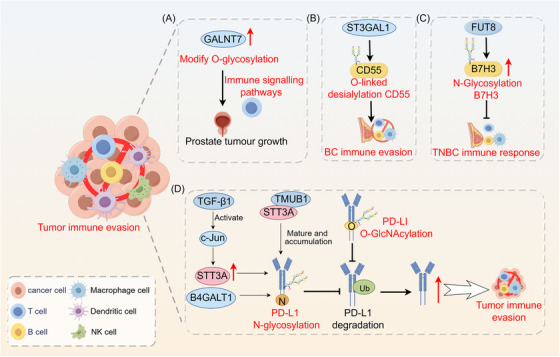FIGURE 3.

Role of glycosylation in tumor immune evasion. (A) GALNT7 modifies O‐glycosylation, which is associated with the immune signaling pathways, in prostate cancer cells. (B) O‐linked salivary modification of CD55 by ST3GAL1 contributes to breast cancer cell immune evasion. (C) Abnormal B7H3 glycosylation mediated by FUT8 suppresses the immune response in TNBC cells. B4GALT1 mediates the N‐linked glycosylation of PD‐L1 protein, thereby preventing PD‐L1 degradation at the post‐transcriptional level. (D) TGF‐β1‐mediated glycosylation of PD‐L1 promotes immune evasion through the c‐Jun/STT3A signaling pathway. TMUB1 enhances PD‐L1 N‐glycosylation and stability by recruiting STT3A, thereby promoting PD‐L1 maturation and tumor immune evasion. O‐GlcNAcylation hinders the lysosomal degradation of PD‐L1 to promote tumor immune evasion. Abbreviations: B4GALT1, beta1,4‐galactosyltransferase 1; B7H3, B7 homolog 3 protein; BC, breast cancer; FUT8, fucosyltransferase 8; GALNT7, N‐acetylgalactosaminyltransferase 7; NK cell, natural killer cell; PD‐L1, programmed death‐ligand 1; ST3GAL1, ST3 beta‐galactoside alpha‐2,3‐sialyltransferase 1; STT3A, STT3 oligosaccharyl transferase complex catalytic subunit A; TGF‐β1, transforming growth factor‐beta1; TMUB1, transmembrane and ubiquitin‐like domain‐containing protein 1; TNBC, triple negative breast cancer; Ub, ubiquitin.
